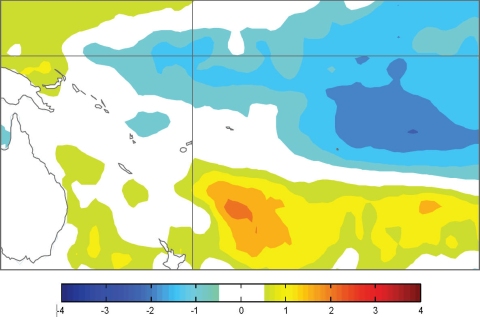The La Niña event in the tropical Pacific has continued to ease, with some indicators weakening substantially but others showing little change as yet.
The La Niña event in the tropical Pacific has continued to ease, with some indicators weakening substantially but others showing little change as yet. The SOI dropped quickly in the second half of March, to +1.3 (estimated) for the month as a whole, with the 3-month mean SOI for JFM 2011 being +1.9. NINO3 and NINO4 SST anomalies have weakened considerably from the beginning of the year, being –0.7°C and –0.8°C respectively in March, compared to their respective values of –1.1°C and –1.4°C in January. The sub-surface temperature anomaly in the far eastern Pacific is now very weak, and the integrated upper–ocean heat content in the tropical Pacific is now everywhere positive except for 90–80°W.
The Equatorial cold tongue, although weaker, is still prominent in the SST anomaly field, but near the South American coast the SST anomalies are around zero with small regions of positive anomaly. Positive SST anomalies in the extra-tropics of both hemispheres (the warm horseshoe) remain in place, but there is noticeable weakening of the southern branch along 40°S east of New Zealand. Conversely, the TRMM ENSO index strengthened to –1.5 for the 30 days to 27 March. Convection is more enhanced over the Maritime Continent and northern Australia than February, and is strongly suppressed near the Dateline just south of the equator. The ITCZ and SPCZ both remain displaced poleward of their normal positions, and anomalous easterly surface winds remain in place near and west of the Dateline. The MJO is currently very weak, and models are equivocal about any future development.
All but one of the models NIWA monitor are predicting ENSO– neutral conditions by the onset of Austral winter. Four long– range models suggest an El Niño event could develop by the end of 2011. Only one model suggests a return to cool La Niña conditions. The NCEP ENSO discussion of 10 March states that La Niña has weakened, and that ENSO–neutral conditions are expected by June. The IRI summary of 17 March rates La Niña as weak to moderate strength, and suggests below 50% for La Niña conditions continuing through April-June 2011.

Surface temperature anomalies (ºC) for March 2011
